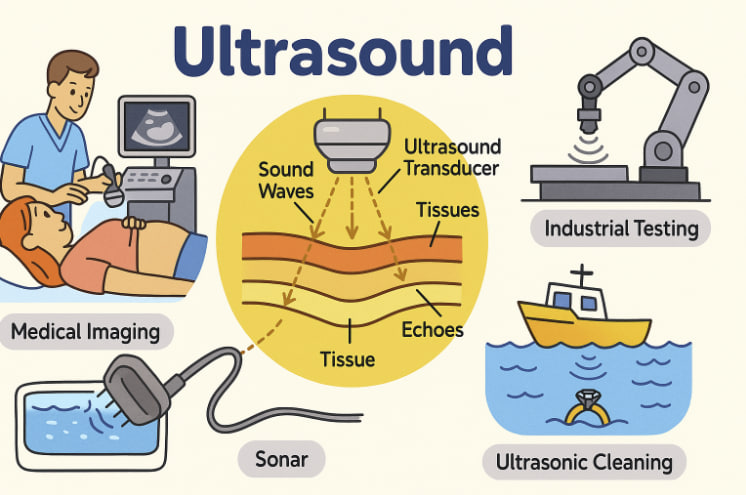Ultrasound is a type of sound wave with a frequency higher than the upper limit of human hearing — typically above 20,000 hertz (Hz). Unlike ordinary sound, ultrasound waves are used in many scientific, industrial, and medical applications due to their ability to travel through different materials and reflect back detailed information about internal structures.
What Is Ultrasound?
Ultrasound refers to mechanical vibrations that move through a medium — such as air, water, or body tissue — at frequencies above what the human ear can detect. These high-frequency waves are generated using special piezoelectric crystals that convert electrical energy into sound and vice versa.
In most applications, a transducer sends the sound waves into a material and then receives the echoes that bounce back. The speed, strength, and direction of these echoes can reveal detailed internal features.
Key Applications of Ultrasound
- Medical Imaging
- Used in prenatal scans to observe fetuses.
- Helps diagnose issues in organs like the heart, liver, and kidneys.
- Enables non-invasive, real-time internal visualization.
- Industrial Testing
- Detects flaws or cracks inside materials (non-destructive testing).
- Inspects welds and structural components in aerospace and construction.
- Marine and Navigation
- Used in sonar systems to map underwater terrain and locate objects.
- Helps submarines detect obstacles or other vessels.
- Cleaning and Processing
- Employed in ultrasonic cleaners to remove fine particles from jewelry, lenses, or medical tools.
- Therapy and Treatment
- Applied in physiotherapy to treat joint inflammation.
- Investigated for targeted drug delivery and cancer therapy.
How Ultrasound Imaging Works
In ultrasound scanning, a probe sends out pulses of ultrasound into the body. When the waves encounter tissues of different densities, they reflect back at different rates. A computer converts these echoes into gray-scale images on a screen, revealing shapes, sizes, and movements of internal organs.
This process is:
- Safe (no ionizing radiation)
- Painless and quick
- Portable, making it useful in emergencies
Advantages and Limitations
Advantages:
- Non-invasive and widely available
- No harmful radiation
- Instant results in many cases
- Useful in both soft tissue and dynamic imaging (e.g., heartbeat, blood flow)
Limitations:
- Poor penetration through gas or bone
- Lower resolution than CT or MRI for certain details
- Operator-dependent — image quality relies on technician skill
Glossary
- Ultrasound: Sound waves with frequencies above 20,000 Hz.
- Transducer: A device that converts electrical energy into sound waves and back.
- Sonar: Use of sound waves to detect and locate objects underwater.
- Non-destructive testing: Inspection techniques that don’t damage the tested material.
- Piezoelectric crystal: A material that generates sound when electrified and vice versa.


